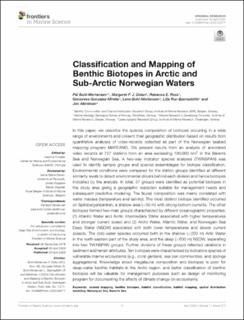| dc.description.abstract | In this paper, we describe the species composition of biotopes occurring in a wide range of environments and present their geographic distribution based on results from quantitative analyses of video-records collected as part of the Norwegian seabed mapping program MAREANO. We present results from an analysis of annotated video records at 757 stations from an area exceeding 100,000 km2 in the Barents Sea and Norwegian Sea. A two-way indicator species analyses (TWINSPAN) was used to identify sample groups and species assemblages for biotope classification. Environmental conditions were compared for the station groups identified at different similarity levels to detect environmental drivers behind each division and hence biotopes indicated by the analysis. In total, 27 groups were identified as potential biotopes in the study area giving a geographic resolution suitable for management needs and subsequent predictive modeling. The faunal composition was mainly correlated with water masses (temperature and salinity). The most distinct biotope identified occurred on Spitsbergenbanken, a shallow area (<50 m) with strong bottom currents. The other biotopes formed two main groups characterized by different oceanographic properties: (1) Atlantic Water and Arctic Intermediate Water associated with higher temperatures and stronger current speed and (2) Arctic Water, Atlantic Water, and Norwegian Sea Deep Water (NSDW) associated with both lower temperatures and slower current speeds. The cold-water species occurred both in the shallow (<200 m) Artic Water in the north-eastern part of the study area, and the deep (>600 m) NSDW, separating into two TWINSPAN groups. Further divisions of these groups reflected variations in sediment and terrain attributes. Ten biotopes were characterized by indicators species of vulnerable marine ecosystems (e.g., coral gardens, sea pen communities, and sponge aggregations). Knowledge about megafauna composition and biotopes is poor for deep-water benthic habitats in the Arctic region, and better classification of benthic biotopes will be valuable for management purposes such as design of monitoring program for documenting the effects of climate change on ecosystems. | en_US |
